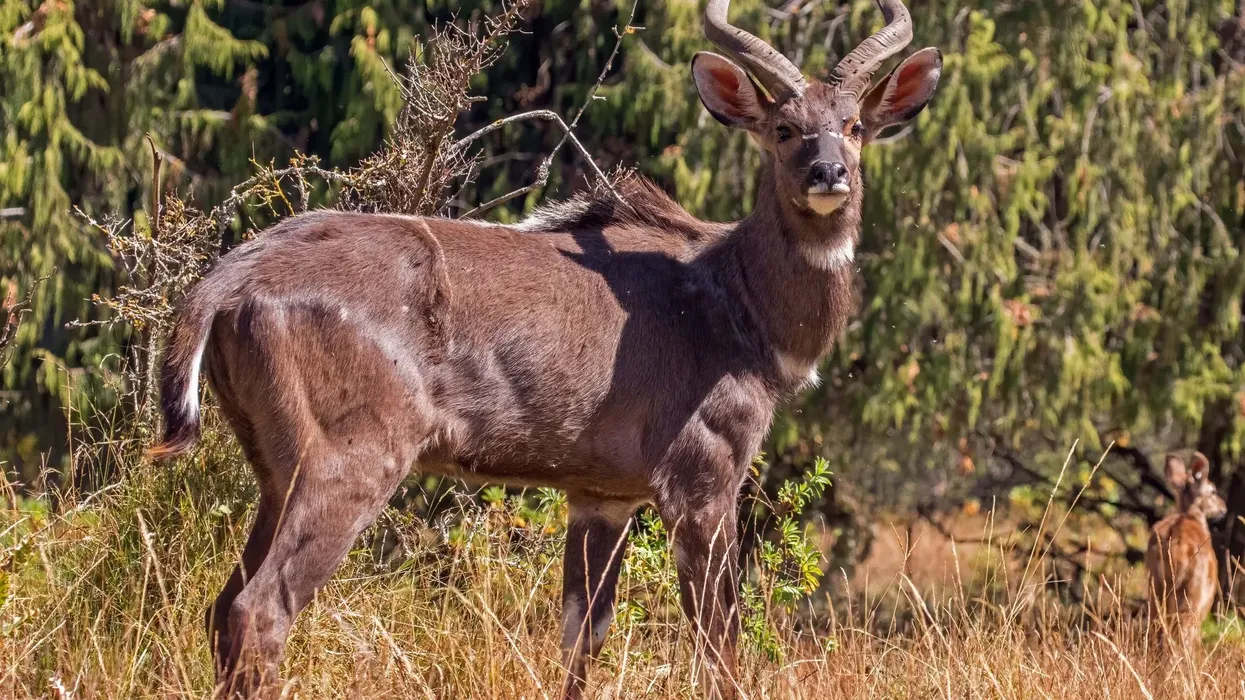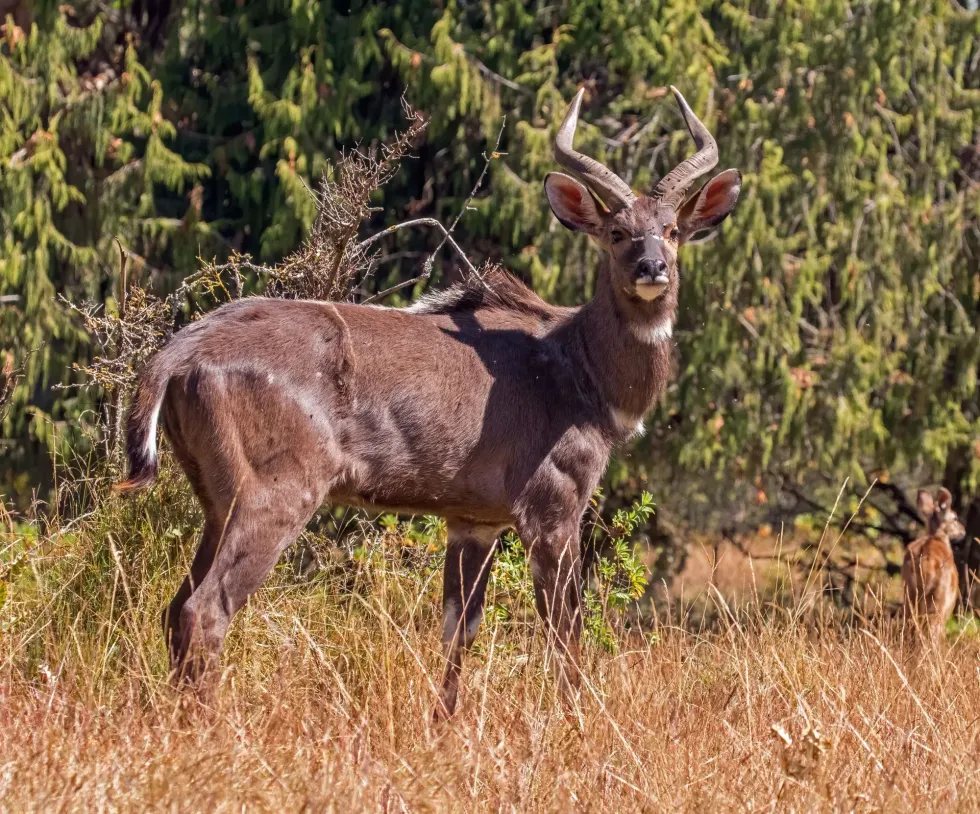The mountain nyala (Tragelaphus buxtoni) is an endemic antelope found in Ethiopia in eastern Africa. These animals are endangered, and their numbers are decreasing due to human encroachment, habitat loss, and hunting. Extensive conservation efforts and further research can help to bring back their population.
In Ethiopia, mountain nyalas are residents of the south-eastern part of the Rift Valley. Most of them are concentrated in the Bale Mountains National Park.
Their habitat usually has forest cover. Male and female nyalas of this species look quite different, with the males being significantly larger. The male mountain nyala also has two horns with yellow tips and one or one and a half spirals.
Mountain nyalas like to avoid interaction with humans and only come out of cover to eat after assessing any signs of danger. They are herbivorous and eat different plants and grasses. Mountains nyalas form an important part of their ecosystem and food chains, as they are a link in the food web.
Leopards are the main predators of mountain nyalas in the wild. Being a fascinating animal, the mountain nyala provides a glimpse of wildlife in Ethiopia.
Keep reading to learn more about mountain nyalas! You can also check out the Nubian goat and Nigerian dwarf goat.
Mountain Nyala Interesting Facts
What type of animal is a mountain nyala?
The mountain nyala (Tragelaphus buxtoni) is an endemic species of the antelope group. The name 'nyala' has an African origin and translates to 'mountain goat'.
What class of animal does a mountain nyala belong to?
A mountain nyala is part of the class Mammalia. This species is in the Bovidae family.
How many mountain nyalas are there in the world?
Unfortunately, the population of mountain nyalas is decreasing, according to the International Union for Conservation of Nature or IUCN, with only 1,500-2,500 adult nyalas present in the wild. Research has shown that the most significant population of this species inhabits the Bale Mountains National Park.
Where does a mountain nyala live?
Nyalas are found in Africa, with mountain nyalas being endemic to Ethiopia which is an east African country. In Ethiopia, their natural range is in the south-eastern part of the Rift Valley.
However, the extent of their range has changed over the years. Currently, their populations are most commonly found in the Bale Mountains National Park and to the east of Bale massif. Smaller fragments of their populations also occur in the west Bale, Arsi mountains, and Chercher or Ahmar mountains.
What is a mountain nyala's habitat?
The habitat of the mountain nyala consists of woodlands, grasslands, heaths, and bush ecosystems. They are forest dwellers and live in high altitudes between 9,842.5-13,779.5 ft (3000-4200 m). These animals use heath forests for cover and protection throughout the year. During the dry season, woodland forests with juniper and Hagenia sp. plants are part of their natural range.
Who does a mountain nyala live with?
Mountain nyalas live with members of their own species, but older male members generally remain solitary. The young male forms small groups or herds of their own with a hierarchy system in place. Larger groups with about two to 13 mountain nyalas are also seen, with more female and young members.
How long does a mountain nyala live?
A mountain nyala can live up to the age of 15-20 years. Their lifespan is similar to that of black-tailed deer in captivity.
How do they reproduce?
The peak reproductive period for this endemic Ethiopian antelope is in December. After successful mating and a gestation period of eight to nine months, a single mountain nyala is born.
They remain protected by hiding in dense cover for a few weeks after birth. Young nyalas have light coats that darken with age. The development of horns in young males starts when they are six months old.
What is their conservation status?
Unlike the lowland nyala, the conservation status of a mountain nyala is marked as Endangered by the International Union for Conservation of Nature or IUCN. The wild populations of this species are under threat mainly due to hunting, human encroachment, and habit loss through commercial development and the building of roads.
Their natural range is also affected by the increase in livestock populations.
Even though mountain nyalas are legally protected, the continual threats put this species at high risk. Further research into their ecology and strict conservation efforts are required to bring this Ethiopian antelope out of danger.
Mountain Nyala Fun Facts
What does the mountain nyala look like?
The mountain nyala possesses two kinds of coats, one during the winter season and one during the summer season. The winter coat is shaggy, while in the summer, it appears smooth. They are usually brown or dark gray in color.
They also have characteristic white body spots and a few vertical white stripes on their sides. These features are common to the species of the genus Tragelaphus. The coats of males darken as they age, whereas females have much lighter coats. Both sexes have long and bushy tails.
Only male nyalas possess horns. Each horn ranges between 33.4-46.7 in (85-118.6 cm) in length. Young mountain nyalas are generally brown in color and do not have distinct body stripes.

How cute are they?
Mountain nyalas are quite fascinating and cute to look at. These mammals also help us learn more about the conservation efforts that should be made to protect their species and other kinds of endangered wildlife.
How do they communicate?
The mountain nyala mainly communicates through vocal and visual methods. Even though these animals are considered to be mostly quiet, they tend to vocalize from time to time.
Female nyalas of this species either produce a low grunt to signify any danger that won't cause immediate harm or a distinct bark to let the others known of immediate danger. Males are generally soundless and don't have specific alarm calls. However, they do bark when approaching females or challenging other males.
How big is a mountain nyala?
In this species, male nyalas are much larger than female nyalas. This is a common characteristic among those belonging to this antelope group.
The length of the head and body in males is between 94.4-102.3 in (240-260 cm), while in females, the range is 74.8-78.7 in (190-200 cm). Their tails are 7.8-9.8 in (20-25cm) long.
The height of mountain nyalas is between 35.4-53.1 in (90-135 cm), with the males being taller. When compared to another related antelope species, known as the greater kudu which is 72.8-96.4 in (185-245 cm) long and up to 63 in (160 cm) tall, the mountain nyala has a slightly greater head and body length, but significantly shorter height.
How fast can a mountain nyala run?
The exact speed of a mountain nyala is not known. In general, nyalas are not very fast animals. In the wild, their most effective defense is hiding or camouflaging themselves.
How much does a mountain nyala weigh?
Males are heavier than females in mountain nyalas. The weight range in males is 396.8-661.3 lb (180-300 kg), while in females, it is 330.6-441 lb (150-200 kg)
What are the male and female names of the species?
Male mountain nyalas are known as bulls, while the females are known as ewes.
What would you call a baby mountain nyala?
A baby mountain nyala is known as a calf.
What do they eat?
The mountain nyala is a herbivorous species. They are mainly browsers but can display grazing behavior from time to time. These antelopes feed on different types of herbs, plants, and grasses.
Rarely, they eat ferns and lichens too. Some of the forest grasses that are part of their diet are species under the genera Poa, Agrostis, and Koeleria. Plants belonging to the tomato family are also a major part of their diet.
Are they dangerous?
Mountain nyalas are not dangerous animals. In fact, members of this species are generally shy towards humans. They prefer to avoid human interactions and modify their feeding times accordingly. Within their population itself, there are some occurrences of male nyalas fighting with each other to establish dominance.
Would they make a good pet?
It would not be possible to keep a mountain nyala from Ethiopia as a pet since they are truly wild animals. Additionally, they are an endangered species and keeping them as pets might further hamper their population and distribution.
Did you know...
The mountain nyala is an integral part of Ethiopian culture. These animals are depicted on the 10 cent coins of Ethiopia.
What is a group of Nyala called?
A group of nyala is known as a herd. Their groups are usually small with two to 13 members. The size of their herd varies depending upon the habitat they are in. For example, their herds are smaller in forests as opposed to open areas.
What is the difference between a kudu and nyala?
A few differences exist between the kudu and nyala, both of which are species of the same genus. Nyalas are shorter in height than kudus. Female nyalas have more stripes on their body than female kudus.
In males, the stripes in nyalas are more prominent than those in kudus. However, male kudus have more conspicuous humps. Another key feature that separates the description of the two is nyalas have yellow tips in their horns, while kudus don't.
Here at Kidadl, we have carefully created lots of interesting family-friendly animal facts for everyone to discover! Learn more about some other mammals including Mauzer dog or Falanouc fun facts.
You can even occupy yourself at home by coloring in one of our free printable mountain nyala coloring pages.








